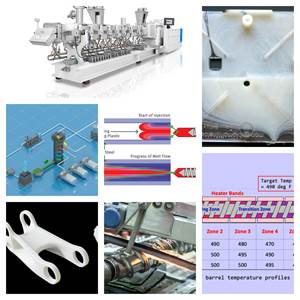Dryers Close-Up
Several dryers introduced at NPE 2000 in Chicago in June offer new technologies that claim to be several orders of magnitude more efficient than conventional hot-air dryers with desiccant beds.
New Dryer Technologies at NPE Aren't Just Hot Air
Several dryers introduced at NPE 2000 in Chicago in June offer new technologies that claim to be several orders of magnitude more efficient than conventional hot-air dryers with desiccant beds. Among them are a new low-pressure dryer that relies on a vacuum to enhance drying and is said to reduce energy use. There’s also a German dryer line built here that’s half the size of conventional desiccant dryers and reportedly uses much less energy.
Vacuum dries faster
Maguire Products Inc., Aston, Pa., launched the Low Pressure Dryer (LPD) that pulls a very strong vacuum of 29 column in. (29.92 in. is a perfect vacuum) on pellets to draw moisture out of them. Vacuum lowers the boiling point of water, so less energy is required for evaporation. Water boils at 212 F at sea level, but at only 130 F in a 29-in. vacuum. The LPD dries at 160-240 F vs. 180-350 F for conventional dryers. Drying at lower temperatures won’t damage heat-sensitive resins and also helps prevent over-drying, adds Stephen B. Maguire, president of Maguire Products and patent holder on the new dryer.
Vacuum drying is reportedly much quicker. Drying time is 40 min vs. 4 hr for a conventional hot-air dryer, says Maguire. Energy use for the LPD 100 is 2 kwH for 100 lb vs. 12 kwH in a conventional unit, Maguire says. The LPD 100 uses two 1400-watt heaters to circulate hot air. The vacuum removes moisture with a proprietary purging step, eliminating need for a desiccant. That saves drying the desiccant, which is 75% of energy cost, Maguire says.
The LPD dryer consists of a carousel with three indexing canisters. The canisters are vacuum chambers, each holding a 1 cu ft of resin or about 35 lb. They rotate at 20-minute intervals—20 minutes to load and heat pellets, 20 minutes to pull the vacuum on hot pellets, and a third canister position for unloading. The dryer does all three procedures at once, indexing pneumatically.
The LPD 100, sized for small extruders and injection presses, dries up to 100 lb/hr or as little as 15 lb/hr. It costs $12,500—roughly the price of a desiccant dryer. In a few months, Maguire plans to offer models for 30 lb/hr and 400 lb/hr.
German technology here
Several U.S. machine makers are beginning to build German dryers here. Comet Automation Systems Inc., Dayton, Ohio, added to its dryer line the Lanco LTA dryer from Lanco & Co. in Hanau, Germany. Comet will continue to build its own small desiccant SD dryers in 15, 25, 50, and 65 lb/hr sizes, but will replace its larger “twin-tower” desiccant bed dryers with Lanco units. The Lanco dryers range from 85 lb/hr up to 2000. They are half the size of conventional desiccant dryers because they use three horizontal desiccant beds, each about 4-in. thick, in flat trays. They use two trays at a time, while the third tray regenerates. Because the beds are thin they regenerate quickly, reducing blower size and using 30% less energy, Comet says.
TDS Technologies Inc., an OEM and R&D firm in Delta, B.C., will build a dryer under license from KM Mutschink GmbH of Germany. It will be available through Farrel Corp., Ansonia, Conn. The new dryer, introduced to North America at NPE, screens and filters fines out of a slurry stage before drying, which produces less dust. Pellets descend in steps through three strainer baskets, each with smaller diameters than the one above. This accelerates centrifugal force and removes water. Pellets are then transported and dried with forced air to residual moisture of 0.4-0.06% by weight, TDS says.
Motan, Plainwell, Mich., will sell a new gas-fired dryer from Germany that’s designed for 48- or 96-cavity PET preform machines. Motan’s new Luxor Gaz model is the gas-fired version of its Luxor 800/1000/1200 dryers. For now, it comes in one size to dry up to 2400 lb/hr. It’s Motan’s first gas dryer and may be the only one on the market with six burners, Motan says.
Universal Dynamics Inc. (a unit of Mann+Hummel) in Woodbridge, Va., introduced a new patent-pending control and hardware modification for more advanced “twin-tower” operation for both electric and gas-fired dryers. Called Pulse Cooling Technology, it adjusts valves and hardware from one desiccant tower to the other for more stable and consistent performance.
Una-Dyn also added 60 and 120 lb/hr hopper sizes to its desiccant-less, compressed-air dryer—the Autodry from Autoload, a company Una-Dyn bought last year.
Related Content
Polyfuze Graphics Corp. Partners With RFID Specialists
To help customers navigate the complexities of RFID technology, Polyfuze has partnered with such companies as HID Global.
Read MorePlastics Technology’s Most-Viewed Articles from 2022
Tips, new technologies, resin pricing, best practices and more piqued reader interest at Plastics Technology in 2022.
Read MoreCompact Entry Rotating-Rack Series of Weather Testers Expanded
Atlas’ Xenotest now also available to meet American standards.
Read MoreOMV Technologies Gets New CEO
Kooper brings 33 years of experience in the industrial and consumer packaging industries to OMV--the closed-loop, turnkey, inline extrusion, thermoforming and tooling systems manufacturer.
Read MoreRead Next
Making the Circular Economy a Reality
Driven by brand owner demands and new worldwide legislation, the entire supply chain is working toward the shift to circularity, with some evidence the circular economy has already begun.
Read MoreLead the Conversation, Change the Conversation
Coverage of single-use plastics can be both misleading and demoralizing. Here are 10 tips for changing the perception of the plastics industry at your company and in your community.
Read MoreFor PLASTICS' CEO Seaholm, NPE to Shine Light on Sustainability Successes
With advocacy, communication and sustainability as three main pillars, Seaholm leads a trade association to NPE that ‘is more active today than we have ever been.’
Read More





















